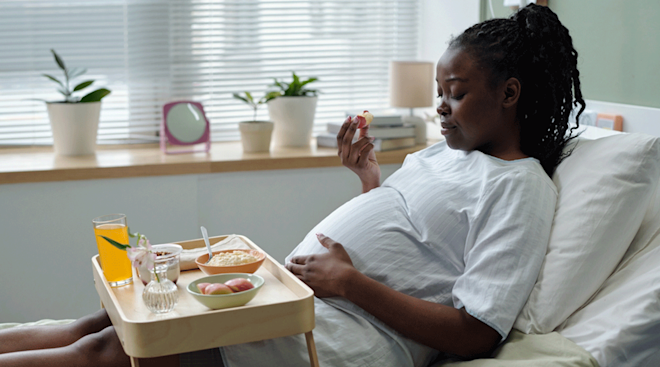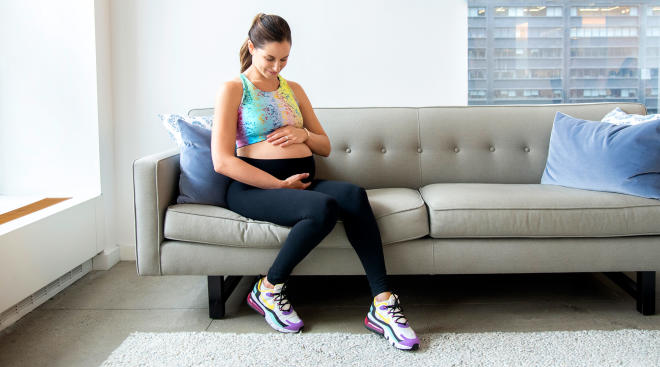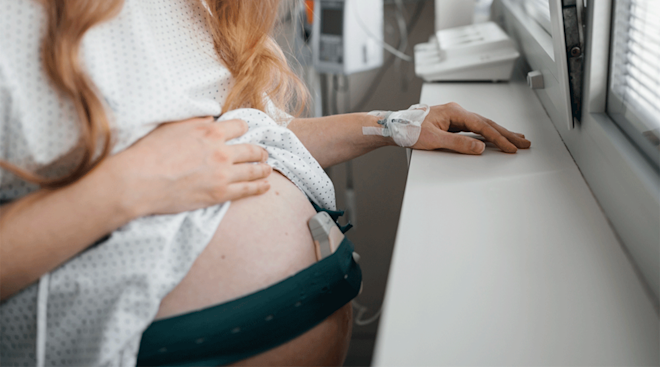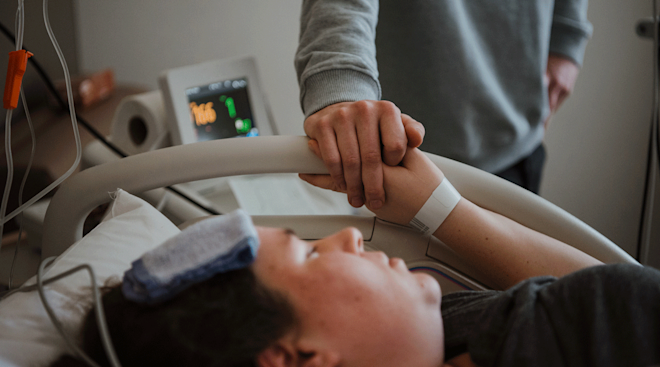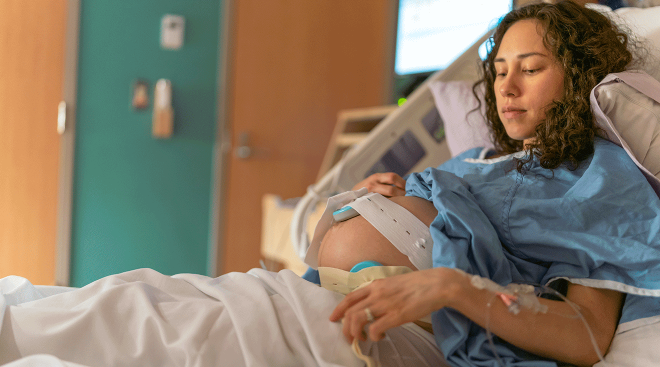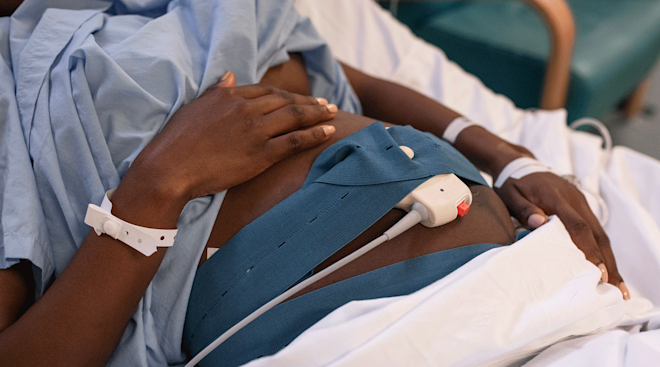Medication-Free Ways to Manage Pain During Labor
Giving birth is probably one of the more physically taxing experiences you’ll face in your lifetime. So it’s not particularly surprising that, according to a survey out of Stanford University, about 71 percent of pregnant women in the US opt to have an epidural to help manage the pain. Of course, that also means that there’s a good portion of (very strong and strong-willed!) women out there who opt for a medication-free birth.
It likely goes without saying, but for the record: Laboring and birthing a baby without drugs won’t be easy. So how should you prepare for a medication-birth, and what are the best techniques to get you from one contraction to the next? Here, experts share some options that work for many moms-to-be—plus, tips for creating a game plan ahead of delivery day.
Many women trying for a medication-free childbirth want more control in the moment and less medical interventions during their experience. They may be interested in pursuing “a more holistic approach to their birth,” explains Elizabeth Nodelman, MD, an ob-gyn and clinical assistant professor at the University of South Carolina School of Medicine. “I think that medicine is generally moving towards a model where patients are really involved in making their own medical decisions, and how they want their pain controlled is a big part of that.”
What’s more, some moms-to-be want the freedom to be able to move around and shift positions as they work through contractions. “When you have an epidural, you can’t get out of bed; with narcotics, you have to wait for it to wear off,” says Rhonda Johnson, DNP, an assistant professor at the University of South Carolina College of Nursing.
Finally, an epidural can inhibit your ability to push, which may require your doctor to try other more invasive interventions, such as forceps or a vacuum to help facilitate delivery. Of course, these situations are relatively rare, so don’t spend too much time worrying about this possibility.
Beyond the main motivations, moms today also have a lot more exposure to what a medication-free birth may look like, thanks to influencers showcasing their own labor and birth experiences on social media. “It’s bringing more light to the ability of a woman’s body, empowering women,” says Laurel O’Neal, CNM, a nurse-midwife at the University of Arkansas for Medical Sciences College of Medicine.
Intrigued by the idea of a medication-free birth? The good news is that most pregnant women—upwards of 95 percent—are good candidates, according to Nodelman. She notes, though, that having an epidural in place is often preferable if you’re expecting twins or multiples, or if your pregnancy is high risk. “You can always have the tubing of an epidural placed and not have anything running through it.” This enables you to have the option if and when it becomes necessary.
First and foremost, understand that contraction pain is subjective, and it can vary from pregnancy to pregnancy. Everyone tolerates labor and delivery pain differently, says O’Neal. Much of early labor tends to be more tolerable and typically feels like strong menstrual cramps. Contractions in the active labor phase can be tough to bear; they’re sharper, more intense and will occur much more frequently. This pain, which will likely require multiple labor-management techniques to get through, is also a sign that you’re ready to head to the hospital or birthing center. Renee Yeager, CNM, a certified nurse midwife with the University of Arkansas for Medical Sciences says that laboring at home for as long as possible typically sets you up for fewer medical interventions.
Whatever your situation, the first step in carrying out a successful medication-free labor and delivery begins well before you head to the hospital. You’ll want to plan ahead and do some proactive learning. Here’s what to consider if you’re thinking about a medication-free birth:
-
Find the right doctor or midwife. Interview different providers to make sure you find one who’ll be supportive of your requests. “You don’t want to fight these types of battles while you’re in labor,” says Yeager.
-
Have support people in place. Whether it’s your partner, a birth doula or a close family member or friend, having someone who can coach you through your pain and advocate for how you want your birth to go is really important, says O’Neal.
-
Attend a childbirth class. This is where you and a partner will learn about intentional breathing techniques and other helpful pain-management tactics.
-
Create a birth plan. This is an integral step in setting expectations for what’s to come. A birth plan is “a tool to help you think through your options,” says Yeager… She adds the caveat that a birth plan is never written in stone, and it’s important to be flexible and adapt as situations change. (Remember that you can also change your mind in the moment.)
Once you’ve officially made the decision to try for a medication-free birth, do your due diligence and research some ways to manage the pain of labor and delivery—it’s important to have a few tricks up your hospital-gown sleeve. Below, eight expert-provided ways to face the physical challenges of childbirth without turning to an epidural or other pain-reducing drugs.
1. Movement
There’s a ton of research showing that walking around and changing your position frequently during labor can decrease pain, expedite the process and boost your chances of having a vaginal birth. “When you’re connected to a monitor, it’s easy to feel tied to your bed; any way you can move to help engage your pelvis and shift it is really the best thing you can do,” says O’Neal. As you move, your uterus works more efficiently and your pelvis bones shift to help baby find the best fit through your birth canal, according to The Journal of Perinatal Education.
2. Hydrotherapy
Taking a long shower at home or sinking into a tub of warm water at the hospital or your chosen birthing center can go a long way in easing contractions. Water not only decreases the amount of pain you feel in the moment, but it can also give you a boost of endorphins, which helps you cope with labor, says O’Neal. A 2018 meta-analysis found that women who labored in warm water were less likely to ask for an epidural.
3. Breathing techniques
Intentional breathing during labor can be as simple as inhaling through your nose and exhaling through your mouth, says O’Neal. Practicing some type of abdominal-centric method helps to take your mind off the pain—especially if it’s used in tandem with other comforting measures. “Breathing may not ease pain per se, but it keeps you on top of the contraction and gives you something to focus on,” says Yeager.
4. Massage
Having your doula or support person apply pressure to your lower back, feet, shoulders or hands may help reduce pain. Your partner can try squeezing near the top of your sacrum if you’re having back labor, suggests Yeager. Soothing self-touch can also work: Try gently stroking your belly in a semi-circular motion while sitting upright, says Johnson. This can help steady your breathing.
5. Birthing ball
When you’re upright and shifting your weight around—perhaps sitting on a birth ball—gravity helps bring baby down. What’s more, research shows that women who use birthing balls during labor may have lower pain scores. “The birth ball allows you to sit; it’s soft, and it helps open your pelvis as you move and rock,” says Johnson.
6. Hypnotherapy
Hypnosis is intended to alter what your mind is focused on. A mashup of visualization, mindful awareness and relaxation methods, hypnotherapy and self-hypnosis—or, in this case, hypnobirthing—aims to get you to concentrate on things other than pain, which means you may feel it less. And some studies have shown that moms-to-be find this mind-over-matter methodology and the deep state of serenity it brings to be incredibly effective in reducing pain during childbirth.
7. Aromatherapy
Studies have shown that using essential oils, such as lavender, may be an effective way to reduce anxiety during labor, which can help you endure the pain of contractions. Essential oils help you relax, says Johnson. Use them as you would at home: diffused into the air, dropped into your tub water or massaged into your skin.
8. Play music
Many pregnant women find soothing music helpful during labor, says Nodelman. And there’s no shortage of suggestions online about the best songs to add to your labor and delivery playlist. While research that looks at the anxiety-reducing benefits of music during labor is mixed, there’s evidence that moms-to-be who listen to tunes during early contractions report less intensity of pain.
Labor and delivery are going to be challenging no matter how you decide to proceed; a medication-free experience will certainly test you physically and mentally. But having a support plan in place and practiced techniques will help you manage through the pain. And if things don’t go as expected (or you decide to get an epidural!) that’s fine too. Either way, you’ve got this, mama.
About the experts:
Rhonda Johnson, DNP, APRN, CNM, is an assistant professor at the University of South Carolina College of Nursing.
Elizabeth Nodelman, MD, is an ob-gyn at Prisma Health in Columbia, South Carolina, and clinical assistant professor at the University of South Carolina School of Medicine. She received her medical degree from the Medical University of South Carolina in Charleston.
Laurel O’Neal, CNM, is a nurse-midwife at the University of Arkansas for Medical Sciences College of Medicine. She earned her degree from the Frontier School of Midwifery and Family Nursing in Versailles, Kentucky.
Renee Yeager, CNM, is a certified nurse midwife with the University of Arkansas for Medical Sciences College of Medicine. She earned her master of science in nurse midwifery degree from the University of Cincinnati.
Please note: The Bump and the materials and information it contains are not intended to, and do not constitute, medical or other health advice or diagnosis and should not be used as such. You should always consult with a qualified physician or health professional about your specific circumstances.
Plus, more from The Bump:
Navigate forward to interact with the calendar and select a date. Press the question mark key to get the keyboard shortcuts for changing dates.

































